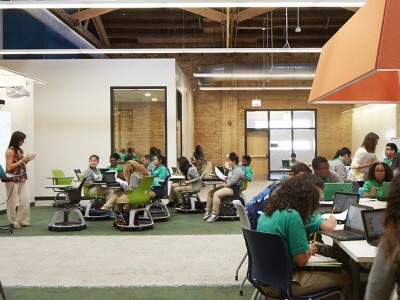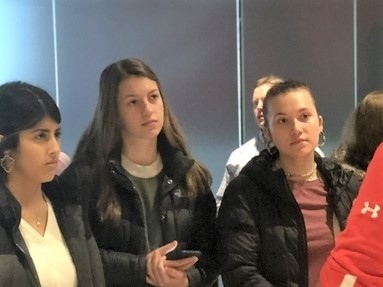Peer Learning Pods: Fostering Collaboration in the Classroom
Topics
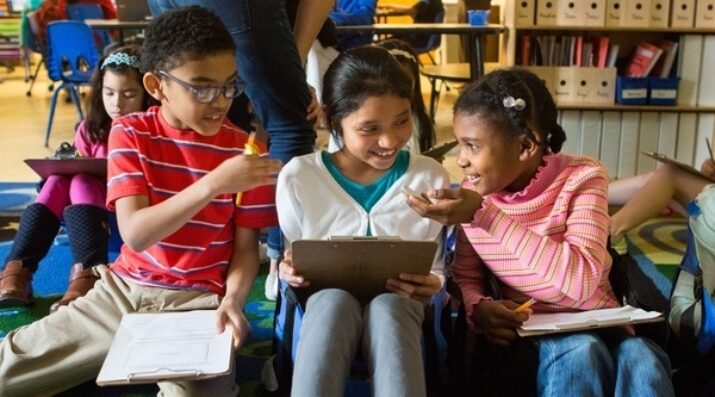
We’ve all had the experience of truly purposeful, authentic learning and know how valuable it is. Educators are taking the best of what we know about learning, student support, effective instruction, and interpersonal skill-building to completely reimagine schools so that students experience that kind of purposeful learning all day, every day.
Learning pods that encourage student-to-student interaction provide opportunities for learners to exchange ideas, give and get feedback, tutor each other, and study together.
Innovations in teaching and learning have had little impact on modern space planning and school architecture. We know that students and teachers do better when they have variety, flexibility, and comfort in their environment. This series examines how next generation learning spaces impact the learning experience for students and their teachers. If you have the opportunity to design a new school building or renovate an existing building, or if you are interested in using space better in your school, this series can help ensure that the physical spaces in your building promote the skills students need to thrive and contribute to an ever-changing global society.
Peer-to-peer learning is an invaluable approach that can enhance academic achievement, foster social and emotional development, and create a collaborative learning environment. It helps students build communication skills, increase engagement, and gain confidence. By integrating peer learning practices into schools, educators can promote a more interactive and supportive learning atmosphere, ultimately preparing students for success both academically and socially.
Peer-to-peer learning is an educational practice where students learn from each other, collaborating to share knowledge, skills, and experiences. This approach not only promotes academic growth but also fosters social skills, critical thinking, and a sense of community. Peer learning can take many forms, including peer tutoring, group projects, discussion forums, and collaborative problem-solving. By actively participating in each other’s learning process, students enhance their own understanding and contribute to the success of their peers.
Learning pods that encourage student-to-student interaction provide opportunities for learners to exchange ideas, elicit feedback on projects, and establish goals to fulfill personal learning objectives. Student-to-student activities may include honest feedback rules, shared activities, student networking, and mentoring.

Credit: Allison Shelley/The Verbatim Agency for EDUimages, CC BY-NC 4.0
Key Elements of Peer-to-Peer Learning
Peer Tutoring: In peer tutoring, more advanced students or those who grasp certain concepts quicker are paired with students who need additional support. The tutor helps explain the material in simpler terms, clarifying doubts, and reinforcing knowledge. This mutual exchange fosters deeper understanding for both the tutor and the tutee.
Group Collaboration: Working together in small groups allows students to tackle projects or assignments in a collaborative environment. Each student brings their unique perspective, and through discussion and collaboration, they arrive at a solution that benefits from diverse input.
Discussion-Based Learning: Peer learning is particularly effective in settings where students engage in discussions and debates. By exchanging ideas and challenging each other's thoughts, students develop critical thinking and improve their communication skills. It also allows for a broader understanding of different viewpoints and strengthens problem-solving skills.
Peer Feedback: Providing feedback to peers on assignments, presentations, or projects can enhance both the giver’s and receiver’s learning experiences. The act of reviewing another student’s work helps to consolidate knowledge and encourages a reflective approach to learning.
Student-Led Workshops or Study Sessions: In some instances, students organize study groups or workshops where they teach specific topics to their peers. These sessions are often informal and less structured, which helps create a more relaxed learning atmosphere.
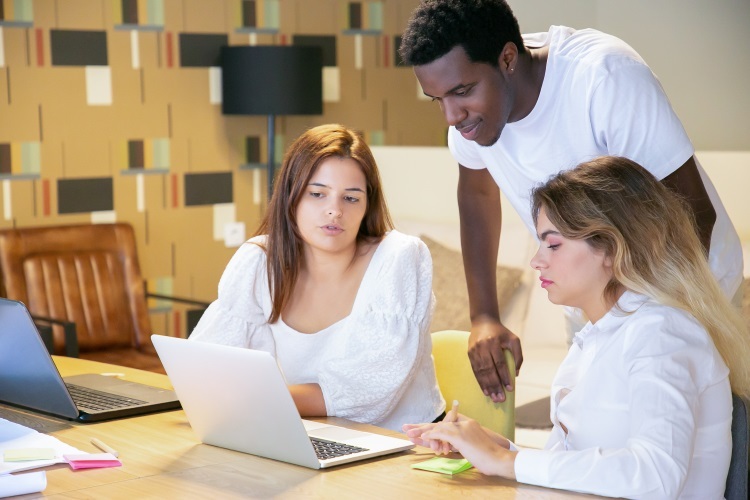
Credit: pch.vector on freepik
Benefits of Peer-to-Peer Learning
Enhanced Understanding: When students teach or explain concepts to one another, they deepen their own understanding. Teaching others requires students to fully grasp the material themselves, as they must communicate it clearly and answer questions that arise.
Increased Engagement: Peer-to-peer learning often leads to higher levels of engagement since students are directly involved in the teaching and learning process. They are more likely to be motivated and feel responsible for the group’s success.
Improved Communication and Social Skills: Peer learning encourages students to communicate clearly, listen to others, and articulate their ideas effectively. These interpersonal skills are essential both in academic settings and in real-life situations.
Confidence Building: When students help their peers, it can enhance their own self-esteem and confidence. The act of sharing knowledge and seeing the impact on others can foster a positive sense of accomplishment.
Fostering a Collaborative Learning Environment: Peer-to-peer learning promotes a cooperative rather than competitive learning culture. It builds a sense of community where students feel comfortable sharing ideas and working together toward common goals.
Cultural and Cognitive Diversity: Working with peers from diverse backgrounds or learning perspectives introduces students to a variety of viewpoints. This exposure broadens their thinking and encourages more inclusive and empathetic learning.
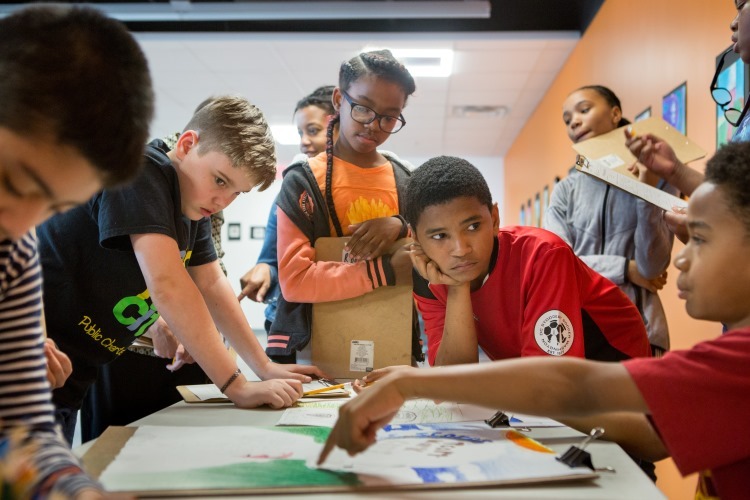
Credit: Allison Shelley/The Verbatim Agency for EDUimages, CC BY-NC 4.0
Considerations for Peer-to-Peer Learning Opportunities
Quality Control: Ensuring that all students are receiving accurate and helpful information can be difficult. Sometimes, peers may misinterpret or inadequately explain concepts, leading to misunderstandings.
Group Dynamics: Not all students work well in groups, and issues like unequal participation or conflict within a group can hinder the learning process. It’s essential to have clear guidelines for group work and provide support for students to work effectively together.
Training and Guidance: Both students and teachers may need guidance on how to effectively engage in peer-to-peer learning. Teachers should provide tools and strategies to facilitate effective collaboration, such as how to give constructive feedback or how to approach peer tutoring sessions.
Time Constraints: Peer learning requires time for students to collaborate, discuss, and support each other. In classrooms with packed curricula, finding the time for peer learning activities can be a challenge.

Credit: ivanglezgar on freepik
How to Integrate Peer-to-Peer Learning in Schools
Structured Peer Tutoring Programs: Schools can implement formal peer tutoring programs where students are trained to help others in specific subjects. This ensures that both the tutor and tutee benefit from the experience.
Group-Based Assignments: Assigning group projects encourages students to work together and share their skills. This approach promotes teamwork, communication, and collaborative problem-solving.
Collaborative Technology Tools: Using online platforms and tools like discussion boards, collaborative documents, and virtual study groups can enhance peer-to-peer learning, especially in remote or hybrid learning environments.
Peer Evaluation and Feedback: Teachers can implement peer review systems, where students provide feedback on each other’s work. This practice not only helps students refine their skills but also teaches them how to assess work critically.
Workshops and Study Sessions: Allowing students to organize and lead study groups or review sessions creates a student-centered approach to learning and empowers students to take responsibility for their educational progress

This learning pod at CICS West Belden in Chicago showcases varied seating with technology and programmable spaces for small groups of two-to-six students to exchange ideas and elicit feedback as well as hone communication skills. Credit: NGLC
Learn More
See the whole series about next gen learning spaces.
Photo at top by Allison Shelley/The Verbatim Agency for EDUimages, CC BY-NC 4.0.



